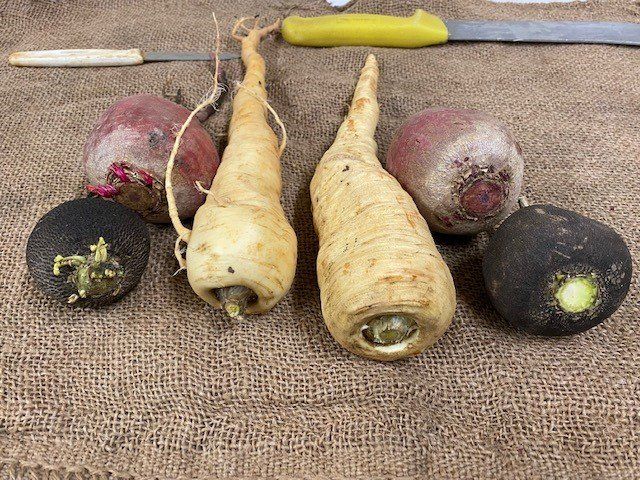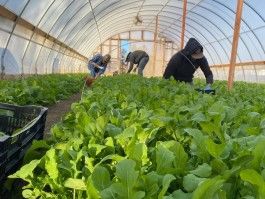Your greens are now coming out of our Hoop Houses (last week too). You'll notice that they are more tender. A Hoop House is basically a large cold-frame (30'x96') with no supplemental heat. We open the doors and roll up the sides every morning for good airflow and then close them before the sun leaves them to keep the warmth in for the night. We also use row cover propped up by metal hoops to add an extra layer of warmth when needed, it's like a blanket for plants but also allows for light, air, and moisture to permeate. We seeded these greens in mid October after removing the heirloom tomatoes and bell peppers out. The weather has allowed them to grow nice and big this year. Keep in mind that this is different than "Hothouse" or "Greenhouse" grown veggies because we are still growing directly in the good dirt of the Earth with natural sunlight and airflow. That's what makes it taste so good!!
Our Fall harvest of dry beans is in this share. Pinto, Hopi Black, and Hopi Red beans are the varieties we grew this year. These are wonderful beans cooked in a pressure cooker, crockpot, or stovetop. the average dry bean in stores is 5 years old, but these are fresh and better for you so they do not need presoaked. In the case of beans, the bean is also the seed. We plant the beans in early summer and they grow much like a green bean, but we allow the plant to mature completely in the field so that the bean pods turn brown and dry. Then it is time to harvest and the real fun begins. We pull out the whole plants, lay them on tarps in the fields to dry further. Then we do our best to separate the plant parts from the beans by agitation and stomping. Soon we have a much smaller pile of beans mixed with lots of debris from the dirt and plants. Cleaning the beans out of the debris takes days of pouring bucket by bucket into our seed cleaner machine (which is basically just a series of different sized screens that vibrate). We do a final clean by "winnowing", which is pouring a full bucket skillfully into an empty bucket in front of a fan so that the lightweight particles drift away. It is a labor-intensive crop but it is good for the soil and we love the diversity it offers to our CSA members. Please enjoy!
Instructions for making beans at home:
Remove debris and rinse. Add 1 cup beans to 4 cups water and bring to boil. Be sure there is always plenty of water to cover the beans. Add salt, and your favorite spices after they are cooked (perhaps some olive oil, onions, garlic too). Taste the delicious difference! You can presoak, but it’s not necessary. Cooked beans freeze well. Black beans- simmer 1.5-2 hrs.; Hopi Red beans- 2hrs; Pinto Beans- simmer 2.5 hrs. Or put them in the crockpot for a half to full day!!




